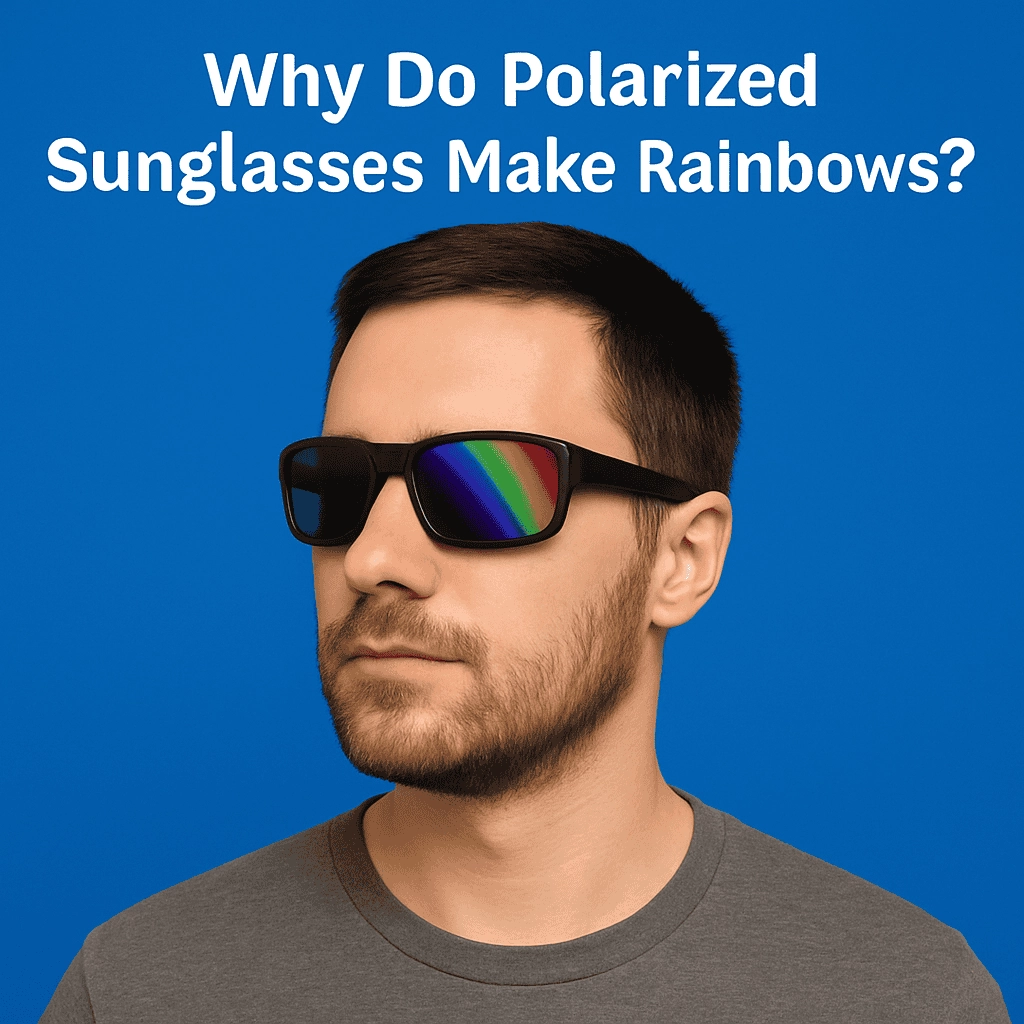When you look through polarized sunglasses, you might notice something unusual – rainbows appearing in your field of view. This visual phenomenon, often surprising and captivating, happens because of the unique way polarized lenses work. These lenses are designed to reduce glare from reflective surfaces, such as water, glass, or snow. However, under certain conditions, they can cause light to interact in ways that produce rainbow-like effects. In this article, we’ll dive into the science behind this effect, explore why it happens, and discuss when it’s a normal occurrence versus a potential issue.

1. Why Do Polarized Sunglasses Make Rainbows?
Polarized sunglasses are designed to enhance vision by blocking horizontal light waves, which are responsible for glare. But here’s the kicker: while they reduce glare, they can also create unexpected visual effects. The rainbow effect is caused by how polarized light interacts with certain reflective surfaces. When light reflects off a surface, it can become polarized. Polarized lenses work by blocking light waves that are oriented in a specific direction. However, this interaction can also result in some light waves being split, creating interference patterns that appear as rainbows.
The rainbows aren’t exactly the same as those seen in a typical rainbow, which is a natural phenomenon caused by water droplets refracting light. Instead, they are a result of interference, similar to what you would see in soap bubbles or oil slicks. This effect can be more noticeable in certain lighting conditions, such as when light is reflecting off water, glass, or even a shiny road surface. The key factor is the angle at which the light is entering your eyes through the polarized lenses.
| Factor | Effect on Rainbow Creation |
|---|---|
| Light Reflection | Creates polarized light waves that can cause interference |
| Angle of Entry | Affects how much light is split, impacting the intensity of rainbows |
| Surface Type | Water, glass, or shiny surfaces enhance the effect |
2. How Do Polarized Lenses Work?
The mechanism behind polarized lenses is fascinating. These lenses have a special filter that blocks horizontal light waves, which are the primary cause of glare. What’s the real story? This filter works by only allowing light waves that are vertically oriented to pass through, significantly improving visibility in bright or reflective environments.
Polarization occurs naturally in many scenarios. For example, light from the sun can scatter off reflective surfaces, such as water, and bounce in a horizontal direction. Polarized lenses block this horizontal light, allowing only vertically aligned light to reach the eyes. This results in a much clearer view without the annoying glare that often obscures the image.
Polarized lenses are especially beneficial for outdoor activities like fishing, skiing, or driving, where reflections can create significant visual discomfort. By eliminating these horizontal light waves, they improve contrast and reduce the strain on the eyes, making it easier to see clearly and comfortably.
| Property of Polarized Lenses | Benefit |
|---|---|
| Vertical Light Filter | Blocks horizontal glare, enhances clarity |
| Contrast Enhancement | Improves visibility in bright conditions |
| Eye Comfort | Reduces strain and visual discomfort |
3. What Causes the Rainbow Effect in Polarized Lenses?
Now that we understand how polarized lenses work, let’s break down what causes those rainbow-like colors to appear. This is where it gets interesting. When polarized lenses interact with reflective surfaces, the light can become scattered in multiple directions. The polarized lens filters out the light that is horizontally polarized, but in doing so, it also causes the light waves to interfere with each other.
This interference creates patterns of constructive and destructive light waves. Where the waves meet in phase (constructively), light intensifies and forms bright areas; where they meet out of phase (destructively), light is diminished, creating areas of darkness. When light travels through a polarized lens, these interactions can split light into different wavelengths, creating the appearance of rainbows.
While this is a fascinating optical effect, it’s important to note that it can be more pronounced depending on the angle of the light, the type of surface, and the quality of the polarized lens.
| Cause of Effect | Resulting Impact |
|---|---|
| Light Wave Interference | Creation of rainbow-like effects due to wave splitting |
| Angle of Polarization | Affects the intensity and visibility of the rainbow |
| Surface Reflection | Enhances the chance of rainbow effects, particularly on water |
4. Are Rainbows in Polarized Lenses Dangerous?
So, are these rainbows something to worry about? The short answer: no, not usually. While the rainbow effect can be a distraction, especially for activities like driving, it’s not typically harmful. But here’s the kicker: in some cases, this visual distraction could impair your ability to focus on essential details, like road signs or other vehicles.
In most situations, the rainbow effect is simply a minor visual quirk, but in certain lighting conditions or at particular angles, it can be more noticeable and cause momentary discomfort. It’s not a sign that your lenses are malfunctioning or harmful to your eyes. However, it is something to be aware of, particularly when using polarized lenses in environments with lots of reflective surfaces.
| Potential Issue | Severity and Solution |
|---|---|
| Distraction During Activities | Moderate – Adjust angle or lens type if needed |
| Visual Clarity Impairment | Low – Not harmful but can hinder focus at times |
| Lens Malfunction | Rare – Typically caused by lens quality or defects |
5. Can Polarized Sunglasses Cause Discomfort?
It’s a great question. Some people do experience discomfort when wearing polarized lenses, particularly when looking at digital screens. The reason behind this discomfort lies in how polarized lenses interact with LCD and LED displays. These screens themselves are polarized, which can create a visual conflict when viewed through polarized sunglasses.
For some users, this causes distortion or a significant reduction in the visibility of screen content. What’s the real story? While polarized lenses are excellent at reducing glare from natural light, they can make digital screens, such as those on smartphones, appear dimmer or difficult to read. This is a common issue but not a reason to avoid polarized sunglasses altogether. If you’re planning to use your sunglasses while checking your phone or looking at an electronic device, consider non-polarized options.
| Surface Type | Effect on Polarized Lenses |
|---|---|
| LCD/LED Screens | Polarized lenses can cause dimming or visibility loss |
| Reflective Surfaces | Polarized lenses excel at reducing glare |
| Water Surfaces | Enhanced visibility, reduced glare and reflections |
6. Do All Polarized Lenses Show Rainbows?
No, not all polarized lenses will show rainbows. The occurrence of the rainbow effect depends on several factors. The quality of the lens, the surface you’re viewing, and the angle at which the light enters the lens all play a role in whether or not you’ll see this effect. High-quality polarized lenses are less likely to cause noticeable rainbows compared to lower-quality lenses.
That said, if you’re wearing high-end polarized sunglasses and you still notice rainbows, it could be due to the type of reflective surfaces you’re encountering. Water, glass, or even a shiny car window can amplify this effect, particularly when the angle of the sunlight or the surface’s texture is just right. So, while it’s not a universal phenomenon, it’s common enough to be a consideration for many polarized lens users.
| Lens Quality | Likelihood of Rainbow Effect |
|---|---|
| High-End Lenses | Lower chance of rainbow effect |
| Standard Lenses | Higher chance of rainbow effect |
| Surface Type | Reflective surfaces increase likelihood of rainbows |
7. How Do Polarized Lenses Improve Visual Clarity?
Polarized lenses are excellent for improving visual clarity, especially in environments with intense light. By blocking horizontal light waves, polarized sunglasses eliminate glare, which can distort vision. What’s the real story? This means you can see more clearly without the visual distractions caused by reflective surfaces, like water, snow, or wet pavement.
For activities like fishing, skiing, or driving, this added clarity is essential. Polarized lenses reduce the need to squint, reduce eye strain, and improve overall comfort in bright conditions. By enhancing contrast, polarized lenses make it easier to see through water or to spot potential hazards on the road.
| Benefit | Impact on Visual Clarity |
|---|---|
| Reduced Glare | Less strain, clearer vision, and improved comfort |
| Enhanced Contrast | Easier to see details, especially in bright settings |
| Eye Comfort | Reduces fatigue, making it ideal for outdoor activities |
8. Why Do Some People Notice Rainbows More Than Others?
It’s not just your sunglasses – your eyes play a significant role too. Some people have more sensitive eyes, which makes them more prone to noticing the rainbow effect. Factors like eye structure, light sensitivity, and even the type of polarized lenses you’re using can affect how you perceive the effect. What’s the real story? Those with more acute light sensitivity may notice rainbows more easily, especially in environments with a lot of reflective surfaces.
Another factor is the angle at which light enters your eyes. A slight change in angle can result in a more noticeable rainbow, so it’s not always the lenses themselves causing the effect but the conditions in which they’re used.
| Sensitivity Factor | Effect on Rainbow Perception |
|---|---|
| Light Sensitivity | More noticeable rainbows, especially outdoors |
| Angle of View | Changes in light angle can intensify the effect |
| Lens Quality | Higher quality lenses may reduce visibility of rainbows |
9. How Do Polarized Lenses Differ from UV Protection Lenses?
Polarized lenses and UV protection lenses are both designed to protect your eyes, but they serve different purposes. UV protection lenses focus on blocking harmful ultraviolet rays, which can cause eye damage over time. On the other hand, polarized lenses primarily focus on reducing glare from reflective surfaces, providing clearer vision.
Polarized lenses are ideal for activities like fishing or skiing, where glare can obscure your view of water or the snow. UV protection lenses, however, are more essential for general eye health, protecting against sun damage and cataracts. What’s the real story? While they both protect your eyes, polarized lenses offer a specialized advantage for reducing glare, while UV lenses offer protection against long-term eye damage from the sun.
| Lens Type | Primary Benefit |
|---|---|
| Polarized Lenses | Reduces glare for better visibility in bright conditions |
| UV Protection Lenses | Protects from harmful UV rays that cause long-term eye damage |
| Combined Lenses | Offers both glare reduction and UV protection |
10. When Should You Use Polarized Sunglasses?
Polarized sunglasses are perfect for activities that involve bright light and reflective surfaces. This includes fishing, skiing, driving, and outdoor sports. The rainbow effect can be more noticeable in these situations, but the benefits of reduced glare and improved clarity often outweigh the minor distractions.
While polarized sunglasses are excellent for reducing glare, there are times when you might not need them. For example, if you’re in a low-light environment or indoors, polarized lenses may not offer any additional benefits. In fact, they could even interfere with screen visibility. So, it’s important to choose the right lens for the right activity.
| Activity | Ideal Use for Polarized Lenses |
|---|---|
| Fishing | Reduces glare on water, making it easier to see fish |
| Skiing | Helps see the snow texture, reducing eye strain |
| Driving | Improves visibility on bright, reflective roads |
| Indoor Use | Not recommended for use in low-light environments |
11. Can Polarized Sunglasses Be Worn for Driving?
Absolutely! Polarized sunglasses are excellent for driving, especially during bright conditions. They reduce glare from the road, other vehicles, and the sky, making driving safer and more comfortable. What’s the real story? With polarized sunglasses, drivers can experience better contrast, less eye strain, and enhanced safety.
However, some drivers may find the rainbow effect distracting, especially when looking at digital displays such as dashboards or GPS screens. If you find this effect bothersome, you might want to consider polarized lenses designed for driving or non-polarized options.
| Driving Situation | Benefit of Polarized Lenses |
|---|---|
| Bright Daylight | Reduces glare, improving road visibility |
| Snowy or Icy Roads | Cuts through glare, enhancing safety and contrast |
| Digital Displays | May cause distortion; consider alternative lenses |
12. How Can You Choose the Best Polarized Sunglasses?
Choosing the right polarized sunglasses depends on several factors. The lens quality, fit, and the specific features you need for your activities are key considerations. Polarized sunglasses come in a variety of frame styles and lens materials, from lightweight plastic to durable metal frames. What’s the real story? It’s essential to prioritize both comfort and performance, ensuring that your lenses fit properly and provide the clarity and glare reduction you need.
Some brands offer additional features, such as anti-reflective coatings or scratch-resistant lenses, which can enhance the durability and performance of the sunglasses. If you’re planning to use them for specific activities, like fishing or skiing, ensure the lenses are designed for those conditions.
| Consideration | Best Choice for Polarized Sunglasses |
|---|---|
| Lens Material | Polycarbonate lenses for durability and impact resistance |
| Frame Fit | Choose frames that suit your face shape and activity |
| Activity-Specific | Look for sunglasses designed for sports or outdoor use |
13. Are There Any Drawbacks of Polarized Sunglasses?
While polarized sunglasses offer many benefits, they do come with some drawbacks. For example, they can make it harder to see certain LCD screens or digital displays, as these devices often have polarized filters themselves. This can be problematic for those who need to interact with their phone or tablet while wearing polarized sunglasses.
Additionally, polarized lenses can be more expensive than non-polarized alternatives. However, for those who spend significant time outdoors or in environments with intense glare, the investment is often worth it. Despite these drawbacks, the benefits of polarized lenses in reducing glare and improving visual clarity far outweigh the negatives for most users.
| Drawback | Solution |
|---|---|
| Screen Visibility | Use non-polarized lenses for screen use |
| Higher Cost | Invest in quality lenses for long-term visual comfort |
| Limited Use | Not ideal for low-light conditions |
14. Can Polarized Sunglasses Protect Against Digital Eye Strain?
While polarized sunglasses are primarily designed to reduce glare from reflective surfaces, they can also help protect against digital eye strain in certain conditions. By reducing glare from screens or overhead lights, polarized lenses can reduce the strain caused by prolonged screen time. What’s the real story? Digital eye strain is a growing concern in today’s screen-heavy world, and while polarized lenses aren’t specifically designed to tackle this issue, they can help alleviate some of the discomfort associated with extended use of digital devices.
| Condition | Polarized Lenses Effect |
|---|---|
| Screen Glare | Reduces glare from screens, providing more comfort |
| Prolonged Exposure | Helps reduce strain from prolonged device use |
| Indoor Lighting | Minimizes glare from artificial lighting sources |
15. How Do Polarized Sunglasses Affect Eye Health Long-Term?
The benefits of polarized sunglasses extend beyond just visual comfort – they also contribute to long-term eye health. By blocking harmful UV rays, polarized lenses reduce the risk of cataracts and other UV-induced eye conditions. What’s the real story? Wearing polarized sunglasses regularly helps protect your eyes from the harmful effects of sun exposure, reducing the risk of long-term damage and maintaining eye health for years to come.
| Benefit | Long-Term Effect on Eye Health |
|---|---|
| UV Protection | Reduces risk of cataracts and macular degeneration |
| Eye Comfort | Prevents strain, which can lead to long-term eye discomfort |
| Health Maintenance | Essential for maintaining healthy vision over time |
Conclusion
Polarized sunglasses are a valuable tool for reducing glare and enhancing visual clarity. While they may create rainbows due to light interference, this effect is generally harmless and adds an interesting visual dimension to the experience. The benefits of polarized lenses far outweigh the minor drawbacks, especially for those who spend time in bright, reflective environments. Whether you’re fishing, driving, or simply enjoying the outdoors, polarized sunglasses can significantly improve your vision and protect your eyes from long-term damage.
FAQ Section
Q1: What are polarized sunglasses?
Polarized sunglasses reduce glare by blocking horizontal light waves, improving visibility in bright conditions.
Q2: How do polarized lenses work?
Polarized lenses filter out horizontal light waves and only allow vertically oriented light to pass through, reducing glare and enhancing clarity.
Q3: Why do polarized sunglasses create rainbows?
Polarized lenses cause light waves to interfere with each other, creating rainbow-like effects, especially when light reflects off surfaces.
Q4: Can polarized sunglasses cause discomfort?
Yes, they can cause discomfort when viewing digital screens, as the polarized filter conflicts with the screen’s own polarization.
Q5: Are polarized sunglasses worth the investment?
Yes, they provide significant benefits for outdoor activities by reducing glare and enhancing visual clarity, making them a valuable investment for many users.

